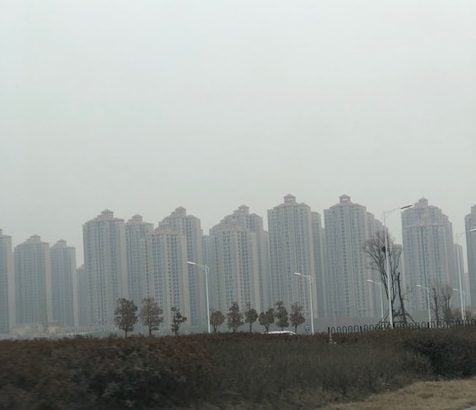
Senator Tom Cotton (R-AR) joined Maria Bartiromo this morning on Sunday Morning Futures. In his interview, Cotton stated at the following at the 3:00 mark on the Chinese Communist regime:
I believe the Chinese Communist leaders, when they were aware of those facts by mid-January, made the conscious decision not to explain to the world that it [the coronavirus] was transmissible between humans, not to shut down travel, not to ask for American or other kind international scientific help, but to allow this virus to escape its borders.Because if they were going to suffer an economic contraction, they were not going to allow the world to prosper and China be the only country whose economy was declining.
We made a similar argument in a post on April 19th but we took it a step further and suggested this might be why the coronavirus was released:
It seems highly unlikely that a country would purposely do something like this that would kill its own people. But the China Communist regime has a history of abusing and killing its own citizens. So maybe it is not so far off as it would appear. But if they did purposely release the virus, why would they do it?
The answer may be because China’s economy was collapsing. This was the regime’s real hold over its people. The country was growing economically and it was winning its economic war with the US. Then came President Trump and in a matter of a couple of years, the feared nation turned into a paper tiger.
Steve Bannon talked about how China was at war with the USA a couple of years ago:
Well here’s the game and right now we are converging on a point and they understand this. We could take the whole thing down. We can take, the whole thing’s built on a house of sand…If they [China] devalue their currency they are just going to flood more out. They got $3 trillion of reserves and trust me, in a New York second that thing would flood out in a second. That’s what their own people think about their economy. We’ve allowed these guys to push us around. We’ve allowed these guys to take the South China Sea…This trade war is going to end in victory and what you’re going to see is a reorientation of the entire supply chain out of China…
Bannon was right and the pressure was on China.
By destroying the world economy they could hide their economic calamity and blame it on the coronavirus. They were losing the economic war badly with Trump and they may have hit the panic button.
WE REPORTED EARLIER THE FOLLOWING 10 REASONS CHINA’S ECONOMY WAS IN TROUBLE:
1. China over built real estate at levels worse than the US in 2008.
We reported in May 2019 that China’s current situation is very similar to the situation in the US that caused the ‘Great Recession’ memorialized in the movie ‘The Big Short’.
China’s actions somewhat mirrored those in the US in 2008. As China grew, it invested in its infrastructure and in addition, it invested in large housing projects throughout the country. These efforts helped bolster China’s already fast growing economy.
The problem is that China over invested in these random properties all over China and these properties today remain empty.
(See below pictures of real estate projects in the middle of China. Seen firsthand in Hubei Province, the epicenter of the Wuhan virus, these complexes are massive but mostly empty.)


There simply are not enough people in the area where these massive complexes were built that make enough money to afford living in these communities. It appears that the Chinese communists’ misunderstanding of supply and demand economics may ultimately be their downfall.
2. Related to real estate crisis is the fact cash-to-short-term debt levels are reaching all time lows for real estate companies.
These many properties throughout China sit unoccupied, and there is a cost to this. Bloomberg reported in September 2018 –
Cash-to-short-term debt levels at more than 80 publicly traded real estate companies tracked by Bloomberg were 133 percent on average in the first half, the worst since the first six months of 2015 and down from 297 percent a year earlier. Almost a quarter of developers sport a ratio below 50 percent.
3. China long term debt is also on the rise.
In addition, Bloomberg noted:
But while business has been booming, developers have also been piling on the debt. Firms have been selling more bonds in the domestic market — and at the cheapest rates as investors shrug off default concerns. Those with dollar-denominated obligations, meanwhile, face higher borrowing costs as the U.S. Federal Reserves continues on its tightening path.
4. The amount of debt in China is massive and the amount is unknown.
The total amount of China debt is unknown with S&P estimating the amount not reported by local communities and banks being over $6 trillion:
China may be sitting on a hidden debt pile of as much as 40 trillion yuan ($6 trillion), concealed off-balance-sheet by the country’s local governments, according to research from S&P Global Ratings.Many local governments in China raise debt and hold it off their balance sheet, in order to avoid lending limits imposed by central authorities. S&P says that this is a growing problem within the country, and that the amount of debt held this way has likely ballooned in recent years.
(Note in the US it is considered fraudulent to maintain off-balance sheet accounts – accounts for liabilities not showing in an entity’s financial statements.)
5. China’s default risk is huge.
The government may have to take over these debts as they become insolvent –
Not only is the level of hidden debt held by local governments in the world’s second largest economy rising, but so too is the risk of those debts being defaulted on. Much of the debt is held by so-called local government financing vehicles (LGFVs), and S&P reports that central government may be willing to let these vehicles file for bankruptcy in the future.“Default risk of LGFVs is on the rise. China has opened up the possibility of insolvent LGFVs filing for bankruptcy, but managing the default aftermath is a formidable task for top leadership,” the report noted….The country’s total non-financial sector debt, which includes household, corporate and government debt, will surge to almost 300% of GDP by 2022, up from 242% in 2016. Fears abound that if this debt pile continues to grow, a spectacular blow up could be imminent.
6. Companies are leaving China in swarms.
I personally spoke with one China CEO last year who I know who said that a fellow manufacturing CEO in China said the economy in China was “terrible”. I also spoke with another head of a manufacturing company in China and he moved his operations to Thailand. He said that there was no more room in Vietnam for his company at a reasonable cost because Vietnam was full as companies from China, so he and his manufacturing plant moved to Thailand.
These are only two instances but are an indication of the economy in China. The problem with this scenario is it provides China no ability to recover. It can only recover with business but the business is all leaving China. They can’t just continue to build and spend.
7. China incurred record corporate bond defaults in 2019.
Corporate bond debt defaults set a record in 2019:
The world’s second-biggest economy ended 2019 with record corporate bond defaults, a result of the slowest growth in nearly three decades. More than 150 onshore companies reneged on debt payments totaling about $19 billion. That was up from 120 companies and $17.6 billion in 2018.
8. China’s ratio of corporate debt to GDP jumped to 160% by the end of 2017.
China’s ratio of corporate debt to GDP is also large:
Fitch, S&P Global and other rating agencies are now warning of more to come as financing dries up for private companies, worsened by the global trade war and a decade of debt-fueled growth coming due. China’s ratio of corporate debt to gross domestic product jumped to a record 160% by the end of 2017 from 101% 10 years earlier.
9. China’s GDP growth rate before the coronavirus was likely negative.
The BBC reported on official China figures from last month. China’s GDP growth is the lowest its been in nearly 30 years and some economists believe it may actually be negative growth.
10. The Wuhan coronavirus is a killer. It’s killing China’s economy!
There are many indications that the China economy is in peril. The coronavirus may have killed it. Can you imagine the US economy totally shut down for a month? That is exactly what is happening in China and Hong Kong now.
Hong Kong’s world class airport handled over 71 million passengers in 2019 which is around 200,000 passengers a day. According to the Hong Kong Immigration Department it’s now down to around 7,000 passengers a day. Hong Kong is not the only major airport in China seeing this pattern. The entire country is this way with almost no international flights going to and from China for the past month.
The streets and roads in some cities are closed down. The roads are empty. This all takes its toll on the economy.
To think that only a couple of years ago under the Obama Administration the world was saying that China was soon to pass the US in GDP and reports were that this may have already occurred.
China was falling fast and hard. Perhaps they ignited the coronavirus as a last ditch effort to save face with their people at home and with countries abroad.
Reading this it makes sense that China may have released the coronavirus intentionally. If not intentionally, Senator Cotton confirms that once the coronavirus was released, China’s actions were economic based.
https://www.thegatewaypundit.com/2020/04/sen-tom-cotton-confirms-tgp-suspicions-china-going-suffer-economic-contraction-not-going-allow-world-prosper/
https://www.thegatewaypundit.com/2020/04/john-podesta-george-soros-connected-consortium-behind-russia-collusion-sham-now-pushing-democrat-coronavirus-investigation/
https://www.thegatewaypundit.com/2020/04/john-podesta-george-soros-connected-consortium-behind-russia-collusion-sham-now-pushing-democrat-coronavirus-investigation/

No comments:
Post a Comment